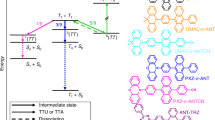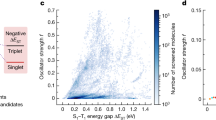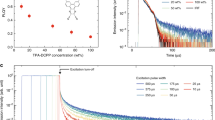Abstract
MORANTZ et al.1 have reported that stimulated emission may be observed from the triplet states of organic phosphors. The emission was characterized by a regular series of spikes of intensity implying an oscillatory condition due to the amplification of the stimulated emission as in similar experiments on ruby. Workers in other laboratories, including our own, have failed to detect this effect. We have, however, succeeded in producing the triplet state of such a compound by the reverse process of direct singlet–triplet absorption using a typical flash photolysis apparatus. This is interesting in its own right as it paves the way for studies of triplet states in the absence of excited singlet states, something which hitherto had not been thought possible. Furthermore, the small fraction of molecules excited in this way is in agreement with calculations which suggest that a prohibitively high inversion population density is required to obtain oscillation in a resonant cavity with such compounds using flashes of energy less than 1,000 joules. Experience suggests that even with a 100-fold increase in flash intensity, such concentrations would be difficult to realize.
This is a preview of subscription content, access via your institution
Access options
Subscribe to this journal
Receive 51 print issues and online access
$199.00 per year
only $3.90 per issue
Buy this article
- Purchase on Springer Link
- Instant access to full article PDF
Prices may be subject to local taxes which are calculated during checkout
Similar content being viewed by others
References
Morantz, D. J., White, B. G., and Wright, A. J. C., J. Chem. Phys., 37, 2041 (1962).
Hatchard, C. G., and Parker, C. A., Proc. Roy. Soc., A, 235, 518 (1956).
Porter, G., and Windsor, M. W., Disc. Farad. Soc., 17, 178 (1954).
Porter, G., and Windsor, M. W., Proc. Roy. Soc., A, 245, 238 (1958).
Christie, M. I., and Porter, G., Proc. Roy. Soc., A,212, 398 (1952).
Lewis, G. N., and Kasha, M., J. Amer. Chem. Soc., 66, 2100 (1944).
Goodman, L., and Kasha, M., J. Molec. Spec., 2, 58 (1958).
Gilmore, E. H., Gibson, G. E., and McClure, D. S., J. Chem. Phys., 20, 829 (1952); 23, 399 (1955).
McClure, D. S., J. Chem. Phys., 17, 905 (1949).
Ermolaev, V., and Terenin, A., J. Chem. Phys., 55, 698 (1958).
Yariv, A., and Gordon, J. P., Proc. Inst. Elec. Electronic Engineers, 51, 4 (1963).
Stockman, D. L., Tittel, K. F., and Mallory, W. R. (submitted to J. App. Phys.).
Author information
Authors and Affiliations
Rights and permissions
About this article
Cite this article
WILKINSON, F., SMITH, E. Stimulated Singlet – Triplet Transitions in Organic Phosphors. Nature 199, 691–692 (1963). https://doi.org/10.1038/199691a0
Issue Date:
DOI: https://doi.org/10.1038/199691a0
Comments
By submitting a comment you agree to abide by our Terms and Community Guidelines. If you find something abusive or that does not comply with our terms or guidelines please flag it as inappropriate.



